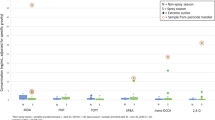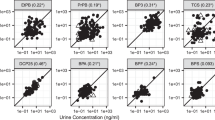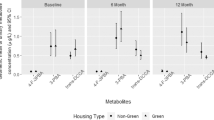Abstract
We used urinary biological monitoring to characterize chlorpyrifos (O,O-diethyl-O-(3,5,6-trichloro-2-pyridinyl) phosphororthioate) exposure to farm family members from Minnesota and South Carolina who participated in the Farm Family Exposure Study. Five consecutive 24-h urine samples were obtained from 34 families of licensed pesticide applicators 1 day before through 3 days after a chlorpyrifos application. Daily 3,5,6-trichloro-2-pyridinol (TCP) urinary concentrations characterized exposure profiles of the applicator, the spouse, and children aged 4–17 years. Self-reported and observed determinants of exposure were compared to the maximum postapplication TCP concentration. All participants had detectable (≥1 μg/l) urinary TCP concentrations at baseline. Applicators' peak TCP levels occurred the day after the application (geometric mean (GM)=19.0 μg/l). Postapplication TCP change from baseline in the spouses and children was negligible, and the only reliable predictor of exposure was assisting with the application for children aged 12 years and older. The applicators' exposure was primarily influenced by the chemical formulation (GM=11.3 μg/l for granular and 30.9 μg/l for liquid), and the number of loads applied. Repairing equipment, observed skin contact, and eating during the application were moderately associated TCP levels for those who applied liquid formulations. Estimated absorbed doses (μg chlorpyrifos/kg bodyweight) were calculated based on TCP excretion summed over the 4 postapplication days and corrected for pharmacokinetic recovery. The GM doses were 2.1, 0.7, and 1.0 μg/kg bodyweight for applicators, spouses, and children, respectively. Chlorpyrifos exposure to farm family members from the observed application was largely determined by the extent of contact with the mixing, loading, and application process.
This is a preview of subscription content, access via your institution
Access options
Subscribe to this journal
Receive 6 print issues and online access
$259.00 per year
only $43.17 per issue
Buy this article
- Purchase on Springer Link
- Instant access to full article PDF
Prices may be subject to local taxes which are calculated during checkout
Similar content being viewed by others
Abbreviations
- FFES:
-
Farm Family Exposure Study
- GM:
-
geometric mean
- GSD:
-
geometric standard deviation
- μg/kg:
-
micrograms per kilogram bodyweight
- μg/kg/day:
-
micrograms per kilogram bodyweight per day
- μg/l:
-
microgram per liter
- NHANES:
-
National Health and Nutrition Examination Survey
- TCP:
-
3,5,6-trichloro-2-pyridinol
- USEPA:
-
United States Environmental Protection Agency
References
Acquavella J.F., Alexander B.H., Mandel J.S., Gustin C., Baker B., and Chapman P., et al. Glyphosate biomonitoring for farmers and their families: results from the Farm Family Exposure Study. Environ Health Perspect 2004: 112: 321–326.
Adgate J.L., Barr D.B., Clayton C.A., Eberly L.E., Freeman N.C., and Lioy P.J., et al. Measurement of children's exposure to pesticides: analysis of urinary metabolite levels in a probability-based sample. Environ Health Perspect 2001: 109(6): 583–590.
Albers J.W., Cole P., Greenberg R.S., Mandel J.S., Monson R.R., and Ross J.H., et al. Analysis of chlorpyrifos exposure and human health: expert panel report. J Toxicol Environ Health Part B 1999: 2(4): 301–324.
Albers J.W., Garabrant D.H., Schweitzer S.J., Garrison R.P., Richardson R.J., and Berent S. The effects of occupational exposure to chlorpyrifos on the peripheral nervous system: a prospective cohort study. Occup Environ Med 2004: 61(3): 201–211.
Baker B.A., Alexander B.H., Mandel J.S., Acquavella J.F., Honeycutt R., and Chapman P. Farm Family Exposure Study: methods and recruitment practices for a biomonitoring study of pesticide exposure. J Expo Anal Environ Epidemiol 2005: 15(6): 491–499.
Berkowitz G.S., Obel J., Deych E., Lapinski R., Godbold J., and Liu Z., et al. Exposure to indoor pesticides during pregnancy in a multiethnic, urban cohort. Environ Health Perspect 2003: 111(1): 79–84.
Brzak K. Analytical method validation for the determination of 2,4-dichlorophenoxy acetic acid (2,4-D) and 3,5,6-trichloro-2-pyridinol (TCP) in human Urine. Dow Chemical Company 2001. Available: http://www.farmfamilyexposure.org/AnalytMeth_24D_TCP.pdf2004].
Centers for Disease Control and Prevention. Second National Report on Human Exposure to Environmental Chemicals 2003. Available: http://www.cdc.gov/exposurereport.
Donaldson D., Kiely T., and Grube A. Pesticide Industry Sales and Usage. 1998 and 1999 Market Estimates. Office of Pesticides, Prevention, and Toxic Substances, US EPA, 2002. Available: http://www.epa.gov/oppbead1/pestsales/99pestsales/market_estimates1999.pdf (accessed July 14, 2004).
Dosemeci M., Alavanja M.C., Rowland A.S., Mage D., Zahm S.H., and Rothman N., et al. A quantitative approach for estimating exposure to pesticides in the Agricultural Health Study. Ann Occup Hyg 2002: 46(2): 245–260.
Fenske R.A., Lu C., Barr D., and Needham L. Children's exposure to chlorpyrifos and parathion in an agricultural community in central Washington State. Environ Health Perspect 2002: 110(5): 549–553.
Gibaldi M., and Perrier D. Pharmacokinetics. Marcel Dekker: New York, 1975.
Hines C.J., and Deddens J.A. Determinants of chlorpyrifos exposures and urinary 3,5,6-trichloro-2-pyridinol levels among termiticide applicators. Ann Occup Hyg 2001: 45(4): 309–321.
Nolan R.J., Rick D.L., Freshour N.L., and Saunders J.H. Chlorpyrifos: pharmacokinetics in human volunteers. Toxicol Appl Pharmacol 1984: 73(1): 8–15.
SAS Institute Inc. SAS 9.1 for Windows. Cary, NC USA, 2003.
United States Environmental Protection Agency (USEPA). Chlorpyrifos Facts. US Environmental Protection Agency, 2002. Available: http://www.epa.gov/oppsrrd1/REDs/factsheets/chlorpyrifos_fs.htm, (accessed July 14, 2004).
USEPA. Chlorpyrifos Revised Risk Assessments. US Environmental Protection Agency. 2000. Available: http://www.epa.gov/pesticides/op/chlorpyrifos.htm, (accessed July 14 2004).
Wilson N.K., Chuang J.C., Lyu C., Menton R., and Morgan M.K. Aggregate exposures of nine preschool children to persistent organic pollutants at day care and at home. J Expo Anal Environ Epidemiol 2003: 13(3): 187–202.
Acknowledgements
The FFES was funded through a grant to the University of Minnesota by Bayer, Dow, DuPont, FMC, Monsanto, Syngenta, and the American Chemistry Council. We appreciate the cooperation of participating farm families and advice from sponsoring company scientists and the FFES Advisory Panel, chaired by Dr. Harris Pastides.
Author information
Authors and Affiliations
Corresponding author
Rights and permissions
About this article
Cite this article
Alexander, B., Burns, C., Bartels, M. et al. Chlorpyrifos exposure in farm families: Results from the farm family exposure study. J Expo Sci Environ Epidemiol 16, 447–456 (2006). https://doi.org/10.1038/sj.jes.7500475
Received:
Revised:
Accepted:
Published:
Issue Date:
DOI: https://doi.org/10.1038/sj.jes.7500475
Keywords
This article is cited by
-
Spatio-temporal assessment of pregnant women exposure to chlorpyrifos at a regional scale
Journal of Exposure Science & Environmental Epidemiology (2022)
-
An algorithm for quantitatively estimating non-occupational pesticide exposure intensity for spouses in the Agricultural Health Study
Journal of Exposure Science & Environmental Epidemiology (2019)
-
Biomonitoring of chlorpyrifos exposure and health risk assessment among applicators on rice farms in Ghana
Environmental Science and Pollution Research (2018)
-
Urinary biomarker concentrations of captan, chlormequat, chlorpyrifos and cypermethrin in UK adults and children living near agricultural land
Journal of Exposure Science & Environmental Epidemiology (2015)
-
Probabilistic assessment of chlorpyrifos exposure to rice farmers in Viet Nam
Journal of Exposure Science & Environmental Epidemiology (2012)



